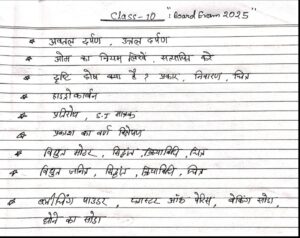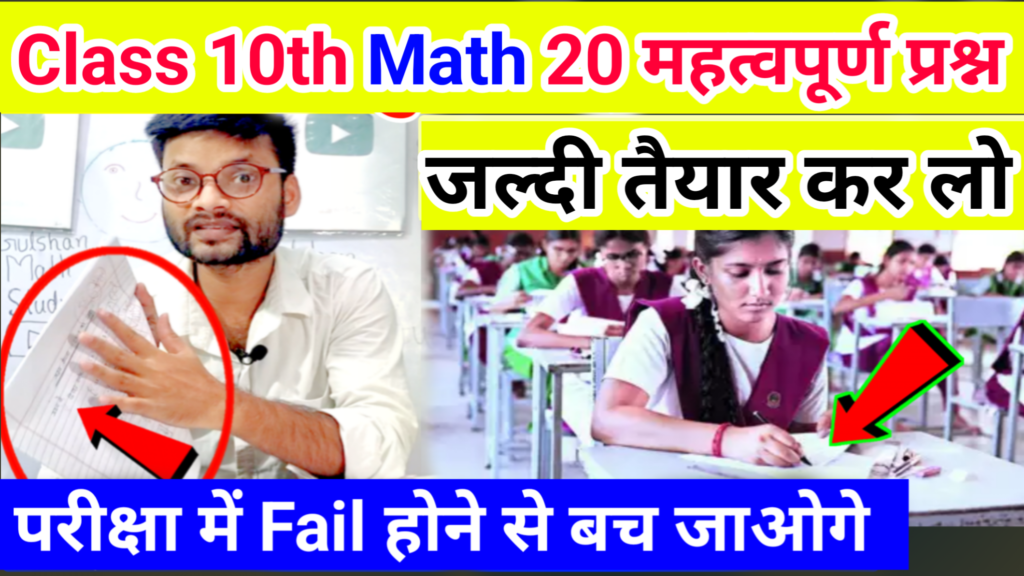Class 10 science important questions 2025
Some Important Question :-

1. अवतल दर्पण, उत्तल दर्पण (Concave Mirror, Convex Mirror)
2. ओम का नियम लिखें, सत्यापित करें (State and Verify Ohm’s Law)
3. दृष्टि दोष क्या है? प्रकार, निवारण, चित्र (What is a Visual Defect? Types, Correction, Diagram)
4. हाइड्रोकार्बन (Hydrocarbons)
5. प्रतिरोध, S.I मानक (Resistance, S.I. Unit)
6. प्रकाश का वर्ण विक्षेपण (Dispersion of Light)
7. विद्युत मोटर, सिद्धांत, क्रियाविधि, चित्र (Electric Motor, Principle, Working, Diagram)
8. विद्युत जनित्र, सिद्धांत, क्रियाविधि, चित्र (Electric Generator, Principle, Working, Diagram)
9. ब्लीचिंग पाउडर, प्लास्टर ऑफ पेरिस, बेकिंग सोडा, धोने का सोडा (Bleaching Powder, Plaster of Paris, Baking Soda, Washing Soda)
यहाँ सभी प्रश्नों के उत्तर हिंदी और अंग्रेज़ी दोनों में दिए जा रहे हैं। सभी विषयों को विस्तार से कवर किया गया है।
1. अवतल दर्पण और उत्तल दर्पण (Concave Mirror and Convex Mirror)
* अवतल दर्पण (Concave Mirror)
परिभाषा (Definition):
अवतल दर्पण एक गोलाकार दर्पण होता है जिसमें परावर्तन की सतह अंदर की ओर होती है। इसे संकेंद्रित दर्पण भी कहते हैं क्योंकि यह प्रकाश को एक बिंदु पर संकेंद्रित करता है।
Definition in English:
A concave mirror is a spherical mirror with an inward-curving reflecting surface. It is also called a converging mirror because it converges light to a focal point.
उपयोग (Uses):
टॉर्च और हेडलाइट्स में
शेविंग मिरर के रूप में
दंत चिकित्सा में
Uses in English:
In torches and headlights
As a shaving mirror
In dental examination tools
* उत्तल दर्पण (Convex Mirror)
परिभाषा (Definition):
उत्तल दर्पण एक गोलाकार दर्पण होता है जिसमें परावर्तन की सतह बाहर की ओर होती है। इसे अपसारी दर्पण कहा जाता है क्योंकि यह प्रकाश को फैलाता है।
Definition in English:
A convex mirror is a spherical mirror with an outward-bulging reflecting surface. It is called a diverging mirror because it diverges light.
उपयोग (Uses):
वाहन के साइड मिरर के रूप में
सुरक्षा और निगरानी में
Uses in English:
As side mirrors in vehicles
For security and surveillance
2. ओम का नियम (Ohm’s Law)
नियम (Law):
ओम का नियम कहता है कि किसी चालक के सिरों पर विभवांतर (V) और चालक में प्रवाहित धारा (I) का अनुपात स्थिर होता है, बशर्ते तापमान और अन्य भौतिक परिस्थितियाँ समान रहें।
Law in English:
Ohm’s Law states that the current (I) flowing through a conductor between two points is directly proportional to the voltage (V) across the two points, provided that the temperature and other physical conditions remain constant.
3. दृष्टि दोष: प्रकार, निवारण, चित्र (Visual Defects: Types, Correction, Diagram)
दृष्टि दोष (Visual Defects)
1. मायोपिया (निकट दृष्टि दोष / Myopia)
कारण (Cause): नेत्रगोलक का आकार अधिक लंबा होना।
निवारण (Correction): अवतल लेंस का उपयोग।
2. हाइपरमेट्रोपिया (दूर दृष्टि दोष / Hypermetropia)
कारण (Cause): नेत्रगोलक का आकार छोटा होना।
निवारण (Correction): उत्तल लेंस का उपयोग।
3. एस्टिग्मैटिज्म (Astigmatism)
कारण (Cause): कॉर्निया की अनियमितता।
निवारण (Correction): बेलनाकार लेंस का उपयोग
Types of Visual Defects in English:
1. Myopia (Nearsightedness)
Cause: Elongated eyeball shape.
Correction: Use of concave lenses.
2. Hypermetropia (Farsightedness)
Cause: Shorter eyeball shape.
Correction: Use of convex lenses.
3. Astigmatism
Cause: Irregular shape of the cornea.
Correction: Use of cylindrical lenses.
4. हाइड्रोकार्बन (Hydrocarbons)
परिभाषा (Definition):
हाइड्रोकार्बन ऐसे यौगिक हैं जो केवल हाइड्रोजन और कार्बन परमाणुओं से बने होते हैं। ये मुख्य रूप से ईंधन के रूप में उपयोग होते हैं।
Definition in English:
Hydrocarbons are compounds made up of only hydrogen and carbon atoms. They are primarily used as fuels.
प्रकार (Types):
1. अल्केन (Alkane)
2. अल्कीन (Alkene)
3. अल्काइन (Alkyne)
5. प्रतिरोध और S.I. मानक (Resistance and S.I. Unit)
प्रतिरोध (Resistance):
प्रतिरोध किसी चालक में धारा प्रवाह का विरोध करने की क्षमता है।
Resistance in English:
Resistance is the property of a conductor to oppose the flow of electric current.
S.I. मानक (S.I. Unit):
प्रतिरोध का S.I. मानक ओम (Ω) है।
S.I. Unit in English:
The S.I. unit of resistance is the ohm (Ω).
6. प्रकाश का वर्ण विक्षेपण (Dispersion of Light)
परिभाषा (Definition):
प्रकाश का वर्ण विक्षेपण वह प्रक्रिया है जिसमें एक किरण को उसके विभिन्न रंगों में विभाजित किया जाता है।
Definition in English:
Dispersion of light is the process in which a beam of light splits into its constituent colors
7. विद्युत मोटर: सिद्धांत, क्रियाविधि, चित्र (Electric Motor: Principle, Working, Diagram)
सिद्धांत (Principle):
विद्युत मोटर का सिद्धांत विद्युत धारा से उत्पन्न चुंबकीय क्षेत्र द्वारा घुमाव उत्पन्न करने पर आधारित है।
Principle in English:
The electric motor works on the principle that a magnetic field is produced by electric current, which creates rotational force.
क्रियाविधि (Working):
विद्युत धारा मोटर के कॉइल में प्रवाहित होती है।
चुंबकीय क्षेत्र कॉइल को घुमाने का कार्य करता है।
Working in English:
Electric current flows through the motor coil.
The magnetic field causes the coil to rotate.
8. विद्युत जनित्र: सिद्धांत, क्रियाविधि, चित्र (Electric Generator: Principle, Working, Diagram)
सिद्धांत (Principle):
विद्युत जनित्र विद्युत चुंबकीय प्रेरण के सिद्धांत पर कार्य करता है।
Principle in English:
The electric generator operates on the principle of electromagnetic induction.
क्रियाविधि (Working):
जब कॉइल को घुमाया जाता है, तो इसमें विद्युत धारा उत्पन्न होती है।
Working in English:
When the coil is rotated, an electric current is generated.
9. ब्लीचिंग पाउडर, प्लास्टर ऑफ पेरिस, बेकिंग सोडा, धोने का सोडा (Bleaching Powder, Plaster of Paris, Baking Soda, Washing Soda)
ब्लीचिंग पाउडर (Bleaching Powder)
रासायनिक सूत्र (Chemical Formula): Ca(OCl)_2
उपयोग (Uses): कीटाणु नाशक, जल शोधन में
प्लास्टर ऑफ पेरिस (Plaster of Paris)
रासायनिक सूत्र (Chemical Formula): CaSO_4·½H_2O
उपयोग (Uses): टूटी हड्डियों के प्लास्टर में, मूर्तिकला में
बेकिंग सोडा (Baking Soda)
रासायनिक सूत्र (Chemical Formula): NaHCO_3
उपयोग (Uses): खाना बनाने में, एसिड को बेअसर करने में
धोने का सोडा (Washing Soda)
रासायनिक सूत्र (Chemical Formula): Na_2CO_3
उपयोग (Uses): कपड़े धोने में, जल को मुलायम बनाने मे
Important Question

1. विरंजक चूर्ण का रासायनिक नाम, सूत्र एवं उपयोग
Chemical Name, Formula, and Uses of Bleaching Powder
Hindi: विरंजक चूर्ण का रासायनिक नाम कैल्शियम हाइपोक्लोराइट है। इसका रासायनिक सूत्र Ca(OCl)_2 होता है। इसका उपयोग जल शोधन, कपड़े धोने, और कीटाणु नाशक के रूप में किया जाता है।
English: The chemical name of bleaching powder is Calcium Hypochlorite. Its chemical formula is Ca(OCl)_2. It is used for water purification, laundry, and as a disinfectant.
2. प्लास्टर ऑफ पेरिस के निर्माण की विधि एवं उपयोग
Method of Preparation and Uses of Plaster of Paris
Answer:
Hindi: प्लास्टर ऑफ पेरिस का निर्माण जिप्सम को 373K पर गरम करने से होता है। इसका उपयोग मूर्तियों, सजावट, और टूटी हड्डियों को जोड़ने के लिए किया जाता है।
English: Plaster of Paris is prepared by heating gypsum at 373K. It is used for making sculptures, decorations, and in setting broken bones.
3. विद्युत स्रोत क्या है? इसका विभांत और विद्यान्त का क्षेत्रीय वितरण
What is an Electric Source? Its Potential and Electric Field Distribution
Answer:
Hindi: विद्युत स्रोत वह उपकरण है जो विद्युत धारा प्रदान करता है, जैसे कि बैटरी। इसका विभांत और विद्यान्त का क्षेत्रीय वितरण इसके चारों ओर समान होता है।
English: An electric source is a device that provides electric current, such as a battery. Its potential and electric field distribution are uniform around it
4. विद्युत जनित्र
Electric Generator
Answer:
Hindi: विद्युत जनित्र एक यांत्रिक उपकरण है जो यांत्रिक ऊर्जा को विद्युत ऊर्जा में परिवर्तित करता है। इसका उपयोग विद्युत उत्पादन में किया जाता है।
English: An electric generator is a mechanical device that converts mechanical energy into electrical energy. It is used in electricity production.
5. दृष्टि दोष क्या है? इसके प्रकार और निवारण
What is Vision Defect? Its Types and Remedies
Answer:
Hindi: दृष्टि दोष का मतलब आँखों की सामान्य दृष्टि में कमी से है। इसके प्रकार हैं – निकट दृष्टि दोष और दूर दृष्टि दोष। इसका उपचार लेंस या सर्जरी द्वारा किया जा सकता है।
English: Vision defect means a reduction in normal vision. Its types are myopia (nearsightedness) and hyperopia (farsightedness). It can be corrected by lenses or surgery.
6. निकट दृष्टि दोष क्या है? इसे दूर करने के लिए हम किस लेंस का उपयोग करते हैं?
What is Myopia? Which Lens is Used to Correct It?
Answer:
Hindi: निकट दृष्टि दोष वह दोष है जिसमें दूर की वस्तुएं धुंधली दिखाई देती हैं। इसे दूर करने के लिए अवतल लेंस का प्रयोग किया जाता है।
English: Myopia is a defect where distant objects appear blurry. A concave lens is used to correct it.
7. अवतल दर्पण एवं उत्तल दर्पण के तीन उपयोग
Three Uses of Concave and Convex Mirrors
Answer:
Hindi:
अवतल दर्पण: टॉर्च, सर्चलाइट, और शेविंग मिरर में।
उत्तल दर्पण: वाहन के साइड मिरर, सुरक्षा मिरर, और स्टोर में
English:
Concave Mirror: Used in torches, searchlights, and shaving mirrors.
Convex Mirror: Used in vehicle side mirrors, security mirrors, and in stores.
8. फेनॉल क्या है? इसका सूत्र और उदाहरण लिखें
What is Phenol? Its Formula and Examples
Answer:
Hindi: फेनॉल एक कार्बनिक यौगिक है, जिसका रासायनिक सूत्र C_6H_5OH है। इसका उपयोग रसायनों और औषधियों में होता है।
English: Phenol is an organic compound with the chemical formula C_6H_5OH. It is used in chemicals and pharmaceuticals.
9. अल्कोहल कैसे तैयार किया जाता है?
How is Alcohol Prepared?
Answer:
Hindi: अल्कोहल को किण्वन प्रक्रिया द्वारा तैयार किया जाता है, जिसमें शर्करा को खमीर की मदद से अल्कोहल में परिवर्तित किया जाता है।
English: Alcohol is prepared by the fermentation process, where sugars are converted into alcohol with the help of yeast.
10. विद्युत धारा, विभवांतर और प्रतिरोध को परिभाषित करें तथा S.I. मात्रक लिखें
Define Electric Current, Potential Difference, and Resistance, and Write their S.I. Units
Answer:
Hindi:
विद्युत धारा: यह विद्युत आवेश का प्रवाह है, इसका S.I. मात्रक एम्पीयर (A) है।
विभवांतर: यह किसी बिंदु पर विद्युत विभव का अंतर है, इसका S.I. मात्रक वोल्ट (V) है।
प्रतिरोध: यह धारा का विरोध करने की क्षमता है, इसका S.I. मात्रक ओम (Ω) है।
English:
Electric Current: It is the flow of electric charge, and its S.I. unit is Ampere (A).
Potential Difference: It is the difference in electric potential at a point, and its S.I. unit is Volt (V).
Resistance: It is the ability to oppose current, and its S.I. unit is Ohm (Ω)
Let me know if you need further assistance with any of these questions.
यह सभी प्रश्नों के हिंदी और अंग्रेज़ी में उत्तर हैं।
Related Tags :-
class 10 science important questions 2025,class 10 science imp question 2025,class 10 science vvi subjective question 2025,class 10 science vvi subjective question 2025,bihar board class 10th science vvi subjective question 2025,up board class 10th science vvi subjective question 2025



